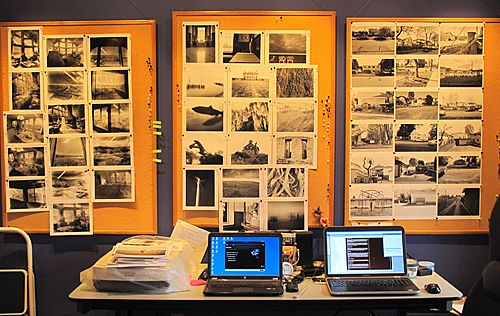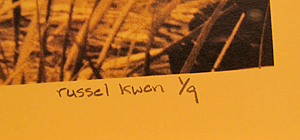Our process for fiber-based
silver-gelatin prints from film
Photography has always been an alchemist’s craft. After the ineffable qualities of mind give a photograph life, hard science and rigorous technique give it beauty and permanence. The magic of photography is only as good as its final form – and for us, that form is a fiber-based silver gelatin print.
Exhibition Prints
Our exhibition prints are fiber-based silver gelatin, single or dual toned in selenium and sulphide, dry mounted with acid-free materials to museum board. Loose prints are available on request. All exhibition prints are created in small editions and the stated edition size represents the total number of exhibition prints that will ever be made. Prints are signed and numbered on the front in pencil or water-based acid-free pigments; negative creation and print dates are recorded on the back.
Printing Process
All prints are hand-printed and tray-processed by Russ and Wendy in their studio darkroom. Prints are developed in a custom two-stage developer to enhance subsequent toning. They are double-fixed for permanence, and fully washed in an archival print washer before toning. Each toning step (selenium and/or sulphide) is followed by a full wash. Prints are air dried on nylon mesh racks.
We occasionally employ unpublished home-brew chemistries and processes to achieve unique effects like silver lift and redeposition (See “Letters From Deyrolle”). To date, we have not observed any loss of print permanence using our home-brews. As all our prints end up containing the same metallic silver, silver-sulphide and silver-selenide components, we expect no loss of permanence in the future.
Evolving a Print
Exhibition prints are evolved, typically over a period of months. Tones are manipulated through various optical and chemical techniques and evaluated as multiple tests on fiber-based papers. Hopefully, a final printing strategy emerges, but some pictures die right here. About 80% of images reaching this stage become exhibition prints.
Work Prints
Images are evaluated and edited in the form of “Work Prints” – cheap, easily processed resin-coated paper (RC) 8x10 prints made in our darkroom. RC prints have a slick, bright white plastic backing, which makes them very easy to distinguish from their fiber-based cousins. RC prints lack the lustre of fiber-based prints and there are open questions about the longevity of its paper/plastic/silver-gelatin laminate – which is why we don’t exhibit RC prints. Our RC work prints are never toned, signed or exhibited, but are retained for future reference. About 1/5 of our work-printed images become candidates for exhibition fiber printing.
Negative Evaluation
About ¼ of the exposures we make get work-printed – the other ¾ are culled on a light-table. We don’t make contact prints, preferring to evaluate negatives directly – a practice that takes much practice.
Processing Film
We personally process all of our film, using a temperature controlled rotary processor for stable results. Operating our own processor allows us to use a variety of custom-tweaked developers – a service commercial labs cannot provide. Film developers determine the final look of a film – enhancing, distorting or diminishing edges, grain, tones and contrast.
Our film is sometimes processed using unpublished home-brew chemistry, with unorthodox techniques to achieve specific results like hyper-overexposure (see “timeless”).
Films
Films are sometimes chosen for specific properties to support specific projects. We do have our favourites: Russ predominately uses Ilford HP5, his main film since 1976. Wendy predominately uses Ilford Delta 400, her main film since 2002.
Certain other films are chosen on a project basis: Ilford Delta 3200 is the film of “Greyhaven”, and Ilford SFx is the film of “We Are Small”.
Two films currently in research are Kodak HIE and HSI high-speed infrared films – long discontinued, but we have an ample supply. We also constantly experiment with many odd and infuriating European films like FOMA, Maco and Bergger.
Cameras
We have a fleet of cameras and lenses, each chosen for their specific capabilities unique to photographic imaging. We do have our favourites: Russ’ principal camera is a Mamiya 7II 6x7cm rangefinder (since 1999), and Wendy’s is a Canon F-1 35mm SLR (since 1988). Both cameras are lightweight and flexible, making them indispensable in our work.
Other cameras go in and out of vogue depending upon the specific visual qualities envisioned for a project. “Hard of Housing” was multi-exposure photographed with a toy Holga camera. “We Are Small” also employed a Holga, but with a fisheye attachment. “timeless” started out with a homemade “Drãnoflex” pinhole and a factory made Zero Image pinhole, but has since moved to Fotoman, Linhof and Wisner 4x5in view cameras with Schneider lenses. We often take Mamiya C330 6x6cm and Mamiya RZ67 6x7cm format cameras into the field. There are many other interesting bits of specialized gear in our closet.
We don’t use zoom or autofocus lenses at all. We often choose single-coated or uncoated lenses over more modern lenses simply because they deliver the “right” kind of image quality for black and white film.
Lights
We never take artificial lights into the field. In the studio, we have an assortment of Speedotron packs, flash heads and modifiers for still life and portrait work.
Gestalt
There are many soft and hard skills involved in creating a photograph between loading the camera and signing the print. We work hard at mastering all of the necessary hard skills without subordinating any of the soft. This is an ongoing journey.


8x10" work prints are often tacked to our studio wall for study
negative and print creation dates are on the back
prints are signed and numbered on the front
our exhibition prints at the Vancouver Gallery of Photography

